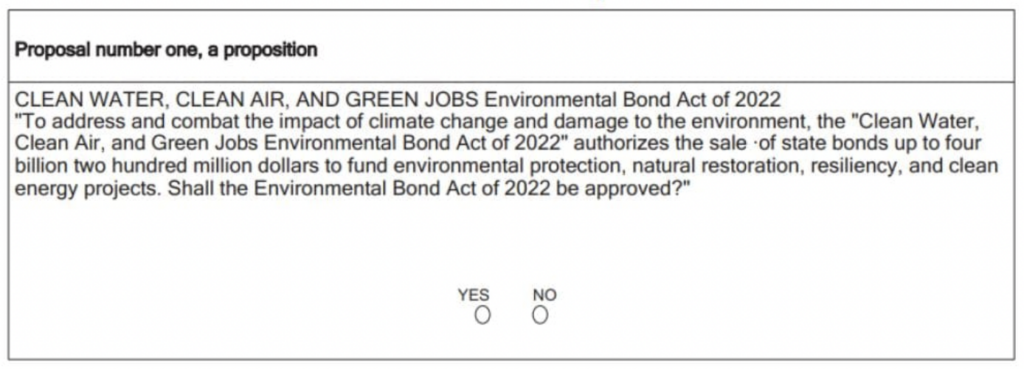In November 2022, New York voters showed their support at the ballot box for the Environmental Bond Act for Clean Water, Clean Air, and Green Jobs. Over 67% of voters in New York voted in favor of this act, and a staggering 81% of voters in New York City voted in support. New York has had 11 environmental bond acts on the ballot since the early 1900s, with all but one passing.
At $4.2 billion in investment, this is the largest environmental bond in New York state history, demonstrating a strong commitment to environmental preservation and sustainability. It also serves as a prime example of how bond acts can help kick-start vital infrastructure upgrades. With communities nationwide facing similar issues, this act provides a practical model for how states can leverage bond acts to secure crucial funding for water, infrastructure, and other environmental improvements.

Ballot example from Sustainable Saratoga https://sustainablesaratoga.org/what-is-the-clean-water-clean-air-and-green-jobs-environmental-bond-act/
Here are five things you should know about this historic New York State funding opportunity:
1. This is the first environmentally-focused bond act in New York since 1996.
Though this is the eleventh proposed environmental bond act in New York, it’s only the tenth one to pass. In 1990, an environmental bond act narrowly failed by three percentage points. However, six years later, the 1996 bond act was successfully enacted, making it the most recent one until the passage of the 2022 act. Former Governor Cuomo proposed a comparable environmental bond act – the Restore Mother Nature Bond Act of 2020 – and hoped to get it passed, but it was ultimately pulled from the ballot due to financial uncertainty stemming from the COVID-19 pandemic.
2. A bond act is funded differently and is exactly what it sounds like.
Bond acts allow a state to take on debt in order to fund projects for a specific purpose. In New York State, bond acts typically require approval by the public through a process called a bond referendum–this is especially true for larger bond issuances. A bond referendum allows state residents to vote on whether the government should be authorized to issue bonds to fund specific initiatives. In this case, the state of New York will obtain funds by selling bonds, these bonds are loans which will be repaid by the state over the next thirty years. This act will not cause an increase in state taxes. Although this bond act is a 4.2 billion dollar investment, experts are estimating the bond act to deliver 8.7 billion in project spending.
3. The bond act is designed to provide long-term support for New York State.
By funding new and expanded projects across the state, the bond act aims to protect drinking water sources, reduce pollution, and shield communities and natural resources from the effects of a changing climate. For a project to be eligible, it must have a minimum useful lifespan of ten years–this includes creating green jobs (an estimated 84,000), promoting environmental justice, and directing at least 35% (with a goal of 40%) of the funds toward disadvantaged communities that are significantly impacted by environmental challenges. The bond act also hopes to help municipalities prepare for severe storms and flooding and plans to preserve the environment by increasing access to open space, protecting farmland, and supporting other similar projects.
4. The bond act will broadly impact the New York water sector.
This forward-thinking initiative addresses critical infrastructure issues such as replacing lead service lines and upgrading long overdue sewer systems. Much of the water infrastructure in New York is approaching or exceeding 100 years old, with many components of the water system in New York City already surpassing their intended lifespan. This bond act aims to address these overdue infrastructure updates and ensure New Yorkers have safe and clean drinking water. It consists of a $650 million fund for Water Quality Improvement and Resilient Infrastructure with at least $200 million for wastewater infrastructure repairs and upgrades, at least $250 million for municipal stormwater projects, and no less than $200 million to support other necessary water-related investments. Specific investments mentioned during one of the state-hosted virtual listening sessions include replacing failing septic systems, upgrading wastewater treatment plants, extending water districts to cover contaminated private sources, and allocating funds to protect drinking water sources from major concerns like agricultural run-off and harmful algal blooms. It’s worth noting that $200 million of these funds were already recently allocated along with another $225 million from the Water Infrastructure Improvement (WIIA) program and Intermunicipal Grants (IMG) to support critically needed wastewater and drinking water infrastructure projects.
5. How you can learn more about the 2022 Environmental Bond Act for Clean Water, Clean Air, and Green Jobs:
There’s currently an ongoing environmental bond act listening tour running until the end of August 2023. This is a great opportunity for New York State communities to learn more about how the funds from this act could be utilized, as well as pitch ideas and speak with state experts. To make it easier for everyone to participate, the state has also provided a survey where anyone can pitch project ideas that are important to them. Although this act is still in the planning stages, New York will soon coordinate sub-allocations to agencies and authorities for specific programs and projects. Some examples of state agencies that will be involved in this project include the New York State Energy Research and Development Authority, the Department of Environmental Conservation, the Environmental Facilities Corporation, and more.
To learn more about the historical 2022 Environmental Bond Act for Clean Water, Clean Air, and Green Jobs, visit the official website of the State of New York.
Sources:
https://www.ny.gov/programs/clean-water-clean-air-and-green-jobs-environmental-bond-act
https://www.dec.ny.gov/about/127431.html
https://www.citizenscampaign.org/new-yorks-2022-clean-water-clean-air-green-jobs-bond-act


